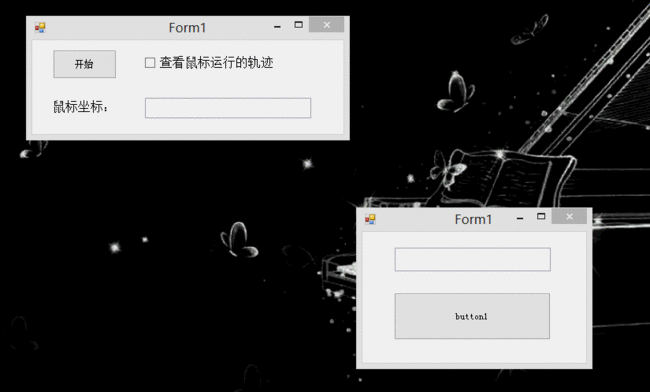C#之鼠标模拟技术
游戏程序的操作不外乎两种——键盘输入控制和鼠标输入控制,几乎所有游戏中都使用鼠标来改变角色的位置和方向,本文主要是讲述如何使用C#调用Windows API函数实现鼠标模拟操作的功能.首先通过结合FindWindow和FindWindowEx寻找到窗体的按钮,在通过SetCursorPos或mouse_event函数操作鼠标,同时涉及到通过spy++工具获取窗体消息的信息.
鼠标自动点击按钮和查看鼠标运行轨迹:
首先创建一个C#工程,设计的窗体如下图所示,同时添加Timer时间器控件:
然后添加的如下代码,即可实现鼠标模拟技术及自动操作鼠标:
using System;
using System.Collections.Generic;
using System.ComponentModel;
using System.Data;
using System.Drawing;
using System.Linq;
using System.Text;
using System.Threading.Tasks;
using System.Windows.Forms;
//引用新命名空间
using System.Runtime.InteropServices;
//StructLayout
namespace MouseAction
{
public
partial
class
Form1 : Form
{
public
Form1()
{
InitializeComponent();
}
//结构体布局 本机位置
[StructLayout(LayoutKind.Sequential)]
struct NativeRECT
{
public
int
left;
public
int
top;
public
int
right;
public
int
bottom;
}
//将枚举作为位域处理
[Flags]
enum
MouseEventFlag : uint
//设置鼠标动作的键值
{
Move =
0x0001
,
//发生移动
LeftDown =
0x0002
,
//鼠标按下左键
LeftUp =
0x0004
,
//鼠标松开左键
RightDown =
0x0008
,
//鼠标按下右键
RightUp =
0x0010
,
//鼠标松开右键
MiddleDown =
0x0020
,
//鼠标按下中键
MiddleUp =
0x0040
,
//鼠标松开中键
XDown =
0x0080
,
XUp =
0x0100
,
Wheel =
0x0800
,
//鼠标轮被移动
VirtualDesk =
0x4000
,
//虚拟桌面
Absolute =
0x8000
}
//设置鼠标位置
[DllImport(
"user32.dll"
)]
static
extern bool SetCursorPos(
int
X,
int
Y);
//设置鼠标按键和动作
[DllImport(
"user32.dll"
)]
static
extern
void
mouse_event(MouseEventFlag flags,
int
dx,
int
dy,
uint data, UIntPtr extraInfo);
//UIntPtr指针多句柄类型
[DllImport(
"user32.dll"
)]
static
extern IntPtr FindWindow(string strClass, string strWindow);
//该函数获取一个窗口句柄,该窗口雷鸣和窗口名与给定字符串匹配 hwnParent=Null从桌面窗口查找
[DllImport(
"user32.dll"
)]
static
extern IntPtr FindWindowEx(IntPtr hwndParent, IntPtr hwndChildAfter,
string strClass, string strWindow);
[DllImport(
"user32.dll"
)]
static
extern bool GetWindowRect(HandleRef hwnd, out NativeRECT rect);
//定义变量
const
int
AnimationCount =
80
;
private
Point endPosition;
private
int
count;
private
void
button1_Click(object sender, EventArgs e)
{
NativeRECT rect;
//获取主窗体句柄
IntPtr ptrTaskbar = FindWindow(
"WindowsForms10.Window.8.app.0.2bf8098_r11_ad1"
,
null
);
if
(ptrTaskbar == IntPtr.Zero)
{
MessageBox.Show(
"No windows found!"
);
return
;
}
//获取窗体中"button1"按钮
IntPtr ptrStartBtn = FindWindowEx(ptrTaskbar, IntPtr.Zero,
null
,
"button1"
);
if
(ptrStartBtn == IntPtr.Zero)
{
MessageBox.Show(
"No button found!"
);
return
;
}
//获取窗体大小
GetWindowRect(
new
HandleRef(
this
, ptrStartBtn), out rect);
endPosition.X = (rect.left + rect.right) /
2
;
endPosition.Y = (rect.top + rect.bottom) /
2
;
//判断点击按钮
if
(checkBox1.Checked)
{
//选择"查看鼠标运行的轨迹"
this
.count = AnimationCount;
movementTimer.Start();
}
else
{
SetCursorPos(endPosition.X, endPosition.Y);
mouse_event(MouseEventFlag.LeftDown,
0
,
0
,
0
, UIntPtr.Zero);
mouse_event(MouseEventFlag.LeftUp,
0
,
0
,
0
, UIntPtr.Zero);
textBox1.Text = String.Format(
"{0},{1}"
, MousePosition.X, MousePosition.Y);
}
}
//Tick:定时器,每当经过多少时间发生函数
private
void
movementTimer_Tick(object sender, EventArgs e)
{
int
stepx = (endPosition.X - MousePosition.X) / count;
int
stepy = (endPosition.Y - MousePosition.Y) / count;
count--;
if
(count ==
0
)
{
movementTimer.Stop();
mouse_event(MouseEventFlag.LeftDown,
0
,
0
,
0
, UIntPtr.Zero);
mouse_event(MouseEventFlag.LeftUp,
0
,
0
,
0
, UIntPtr.Zero);
}
textBox1.Text = String.Format(
"{0},{1}"
, MousePosition.X, MousePosition.Y);
mouse_event(MouseEventFlag.Move, stepx, stepy,
0
, UIntPtr.Zero);
}
}
}
同时自定义一个对话框,增加一个button按钮,其运行结果如下图所示:
原文地址:http://www.2cto.com/kf/201410/343342.html

